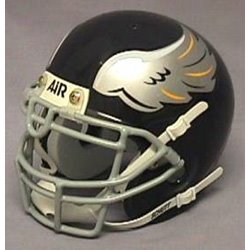
Flashback to a decade ago. Southern Miss and Houston finished tied atop the newly formed Conference USA. Houston owned the tiebreaker thanks to their head to head victory over the Golden Eagles and went to the Liberty Bowl. Southern Miss was forced to stay home for the holidays despite their 8-3 record and road victory over Georgia (their other two losses came at Alabama and Florida State). With the glut of current bowl games, both schools will be participating in the postseason. Since that inaugural 1996 season, Southern Miss has been a consistent player in the Conference USA race—winning championships in 1997, 1999, and 2003, posting a winning record every season (including this season’s 8-4 mark), and participating in 8 bowl games. The constant in that span has been head coach Jeff Bower. In fact he’s been with the program since 1990 and if he’s not careful, he could become more synonymous with Southern Miss football than Brett Favre. It’s been a different story for the Houston Cougars. They have yet to add a second championship to their ledger, finished with a losing record 6 times, and played in only 2 bowl games. In fact, as recently as 2001, the Cougars finished winless. Things changed in 2003 when Houston hired head coach and former Cougar player Art Briles. Briles was an outstanding high school coach, who won 4 state titles in football-crazy Texas. In 2003, the Cougars, coming off 3 consecutive losing seasons, finished 7-6 and participated in the Hawaii Bowl. They slumped to 3-8 in 2004, and then improved to 6-6 with a Fort Worth Bowl appearance in 2005. This is by far Briles best team at Houston. The Cougars are 9-3, with a 3-game losing streak sandwiched between an opening 4-0 start and a closing 5-0 salvo. The three losses were all by 4 points or less. They lost by 1 to Miami in the Orange Bowl, by 3 in an inexplicable home loss to Louisiana-Lafayette, and by 4 at Southern Miss.
Checking out the box score from October 14th reveals a very closely contested (not surprising given the final score). Houston out gained Southern Miss by about 50 yards and both teams turned the ball over once. However, one play early in the game helped Southern Miss take an early lead and played a huge role in the games outcome. On a fourth down play late in the first quarter from their own 31-yard line, Houston long-snapper Norby Juist snapped the ball over punter Justin Laird’s head. Laird tracked the ball down some 30 yards later at his own one-yard line. Southern Miss took over at the one-yard line and in short order made it 7-0. Had Laird been able to kick the ball out of the endzone, instead of recover it at the one, the outcome of the game could have been quite different.
This game should come down to the play of the two quarterbacks. Houston’s senior quarterback Kevin Kolb had a terrific season throwing 25 touchdowns and just 3 interceptions while completing over 68% of his passes. On the other sideline, Southern Miss quarterback Jeremy Young is not quite as accomplished a passer (11 touchdown passes, 5 interceptions, 57% completion percentage), but is still a solid quarterback.
Prediction: Houston lost the first game thanks to a high snap on a punt and the Golden Eagles' homefield advantage. The neutral site and advantage at the quarterback position should allow Houston to win their second Conference USA championship.








